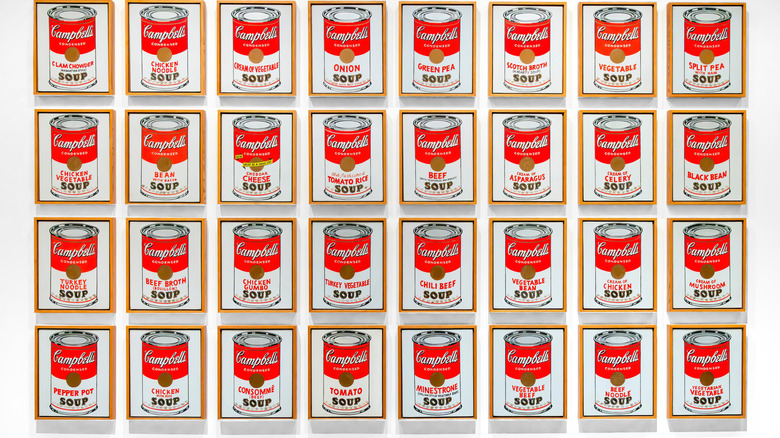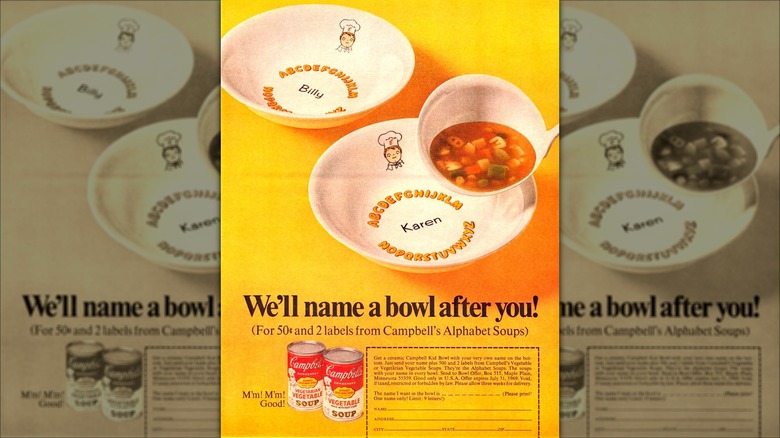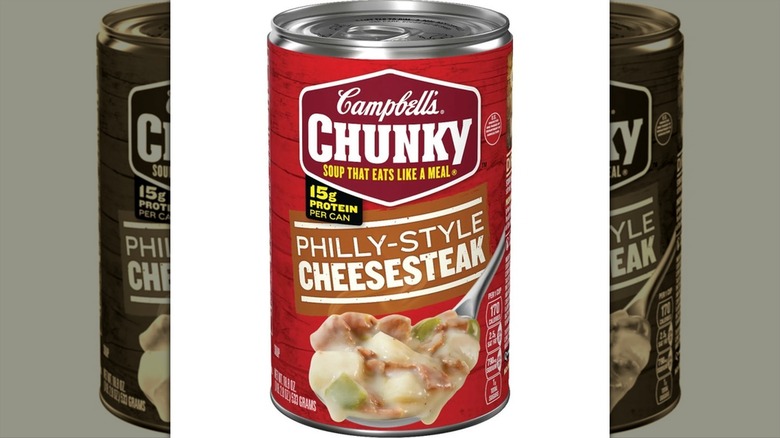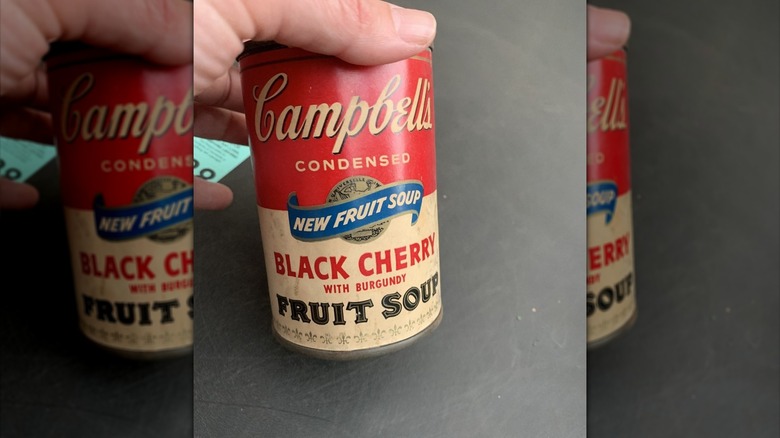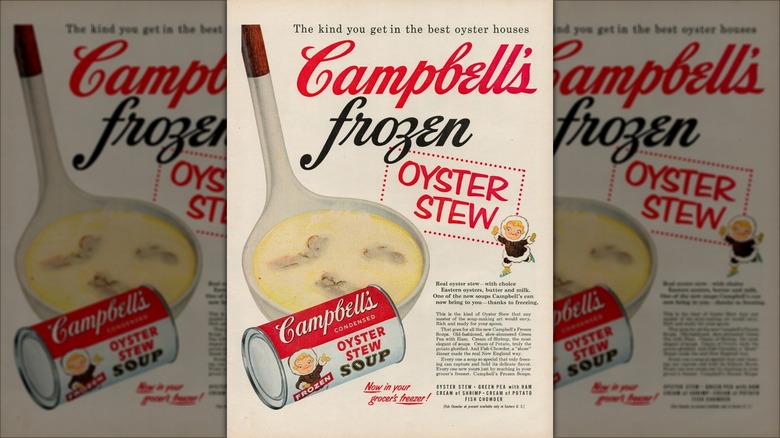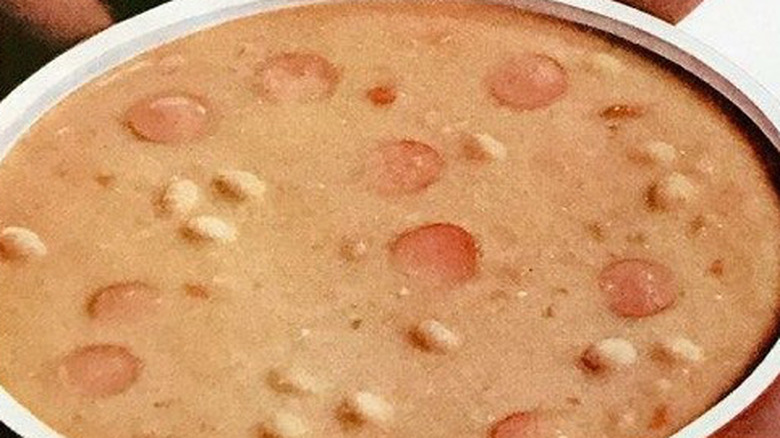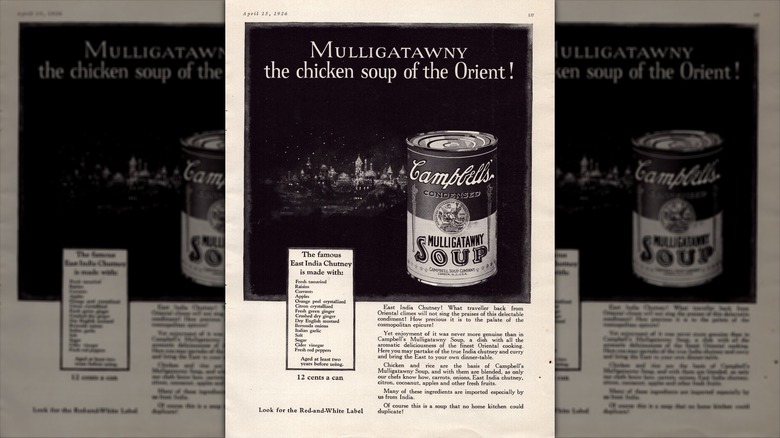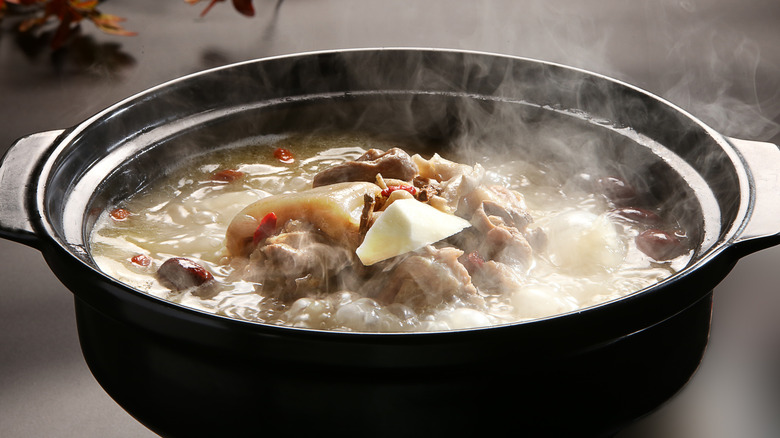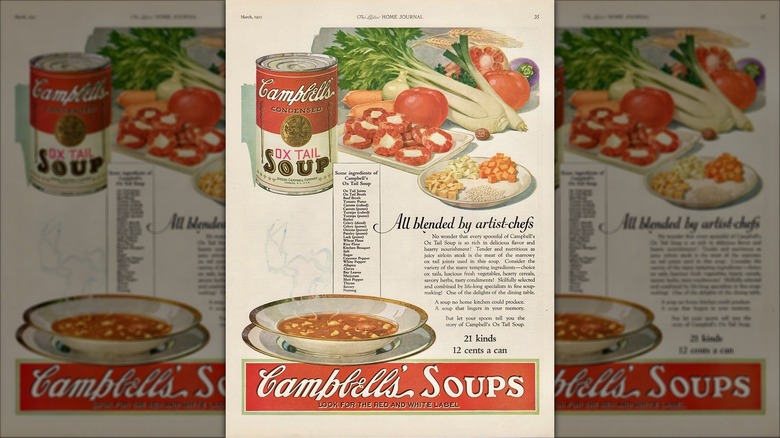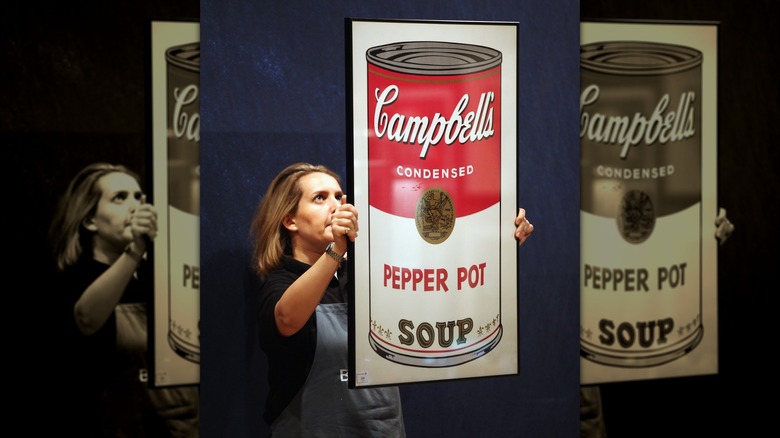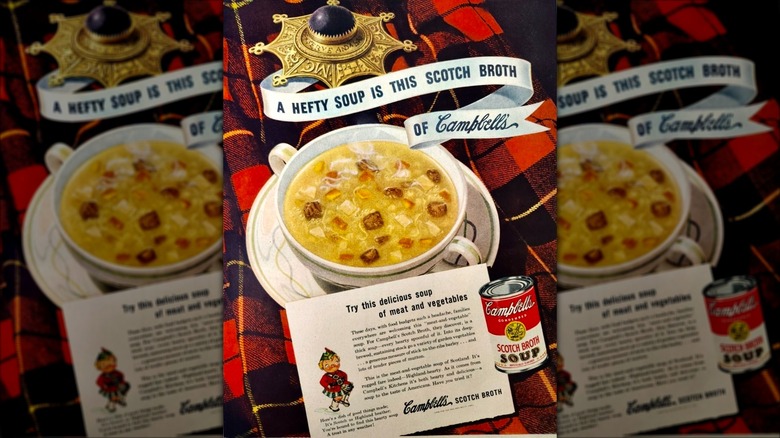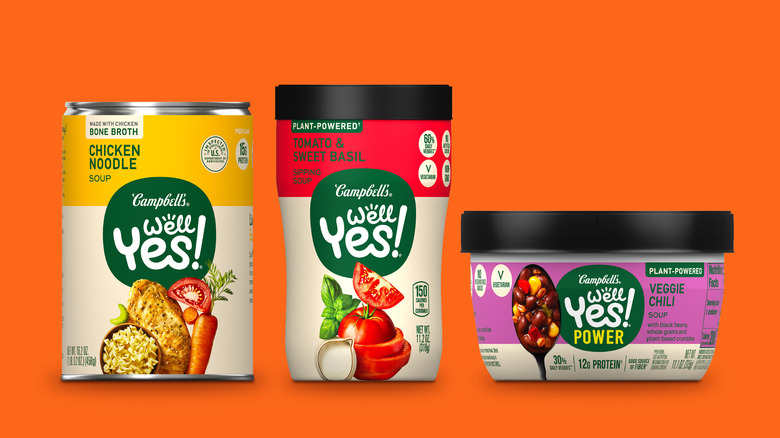Discontinued Campbell's Soups We Wish Would Return
We may receive a commission on purchases made from links.
Joseph Campbell's specialty was selling fruit and veggies wholesale, and his partnership with commercial canner and packer Abraham Anderson in 1869 laid the groundwork for what would eventually become the Campbell's Soup Company. Campbell's introduced its first ready-to-eat soup, Beefsteak Tomato, in 1895 — in the century and change since, a plethora of flavors have joined it on shelves, and are beloved by millions around the world.
Sadly, tastes change, and some soups that were once greatly popular face uncertain futures in modern times. For lack of sales, or interest, Campbell's has unfortunately had to say goodbye to many a flavor over the years. Sure, some of those cans have been forever immortalized in the pop-art screen prints of Andy Warhol, but many remain just a memory for one generation or another. Let's pay tribute to a dozen discontinued Campbell's soups we wish would return.
Alphabet Soups
While it's unclear when Campbell's first introduced a soup with noodles shaped like the letters of the alphabet, one early reference dates back to 1930. Then again, it was somewhat joked about, as the The Ringling Eagle of Oklahoma printed the following ad the above the masthead: "Women Won't Feed the Husband Campbell's Alphabet Soup for Fear He'll Get the Last Word!" By 1968, letters were definitely lining cans of vegetable soup, and a year later, Andy Warhol paid tribute to a can of one with a screen print.
The playful nature of letter-shaped pasta begat an expansion of offerings for kids, with the introduction of Meatball Alphabet and Chicken Alphabet soups in 1975. The popularity of the line expanded beyond the can, with personalized soup bowls, a game, set of crayons, series of books, dolls, and even a Barbie honoring the offering.
The last version of an alphabet soup under Campbell's good name appears to be Tomato A to Z's, but it too seems to have been suspended from schooling appetites. The closest one can get these days in the brand is its SpaghettiOs — Original A to Z's shaped pasta. Perhaps adding some water to the tomato sauce will make it a bit more soup-like.
Chunky Philly Style Cheesesteak Soup
The cheesesteak is the staple sandwich of Philadelphia, and has lent itself to many emulations and imitations far beyond this Pennsylvania city's limits. We're not sure the world asked for it in soup form, but in 2014, Campbell's sub-label Chunky gave it the old college try. On paper, a Philly-Style Cheesesteak soup sounds as delicious as it does divisive. The ingredients list tried to stay true to the genuine article, tossing in seasoned cooked beef, roasted onions, green peppers, and beef tallow, along with chunks of potatoes and numerous cheeses running the gamut from cheddar, to blue cheese, Swiss, and even cream cheese ... although we're not sure it was the Philadelphia-branded kind. There was even a dash of "grill flavoring" in the form of vegetable oil.
Its release was given a boost by the appearance in ads of footballer Clay Matthews, who was an odd choice. Campbell's even boasted its greatness, noting, "Trust us, after one bite you'll want to reinvent your cheesesteak-eating routine with a spoon." The soup itself looked like clam chowder, and leaned more on its cheesy and onion aspects than the promised steak appeal. One reviewer who enjoyed it essentially called it a creamy potato soup with bits of dried beef.
Philly-Style Cheesesteak never really scored a touchdown with fans, and was eventually benched from the Chunky team. Yet there is definitely potential in this flavor. Perhaps if there was more of a presence of the steak, and the inclusion of the cheeses actually found in this Philly phenomenon — "wit" provolone or Cheez Whiz — then this Eagle could fly higher.
Fruit Soups
When the weather calls for cold and refreshing soups, ones like a veggie-loaded gazpacho or a nice borscht will do the trick. Something few people think about is a fully fruit-based soup. And yet, starting in 1958, Campbell's bet that consumers would grow to love a new line of Fruit Soups. The first trio of flavors dropped were Orange Fruit Soup, which included apricots and white grapes; Prune Fruit Soup, with the aid of apricot and orange; and Black Cherry Fruit Soup, which brought together the talents of pitted black cherries and a cherry broth seasoned with Burgundy.
Campbell's posited its Fruit Soups as a universal treat that could be enjoyed hot or cold, by any age of consumer and at any time of day. They also didn't just have to be enjoyed as soups, and offered up plenty of recipes to suggest other uses. The Fruit Soups could work double duty as sauces for cereals, ice creams, covering meat, dressings for salads, turned into gelatin molds, or turned into full-fledged desserts.
While a lot of effort was put in by Campbell's to push its Fruit Soups into market, the public perhaps wasn't exactly ready for such a curveball of a treat. A grocery store columnist known as The Acme Man noted in The Akron Beacon Journal at the time, "I will have to admit they are rather unusual." They disappeared not long after their debut, but we wish they'd return for a second chance.
Frozen Soups
Ages before the company was peddling Disney's Frozen-branded soups, it was selling actual frozen soups. The initial set of flavors introduced in 1955 included Oyster Stew, Cream of Shrimp, Clam Chowder, Fish Chowder, Cream of Potato, and Green Pea with Ham. Later, Old-Fashioned Vegetable with Beef, Lobster Langostino Bisque, New England Style Fish Chowder, and Snapper joined the lineup.
To help sell these new soups, ads featured one of the ever-smiling Campbell's kids in a parka-type jacket, carefully handling the goods with gloves. The company also emphasized that these hearty winter soups were also perfect for summertime enjoyment, and freezing them helped seal in the freshness of the contents.
Over time, many of the frozen soups in the line-up were discontinued or later sold as regular room temperature versions, like Cream of Shrimp. Sadly, Oyster Stew was lost by at least 2012, and the frozen soup line petered out sometime after 2017. Gone, but not forgotten. Babette Morgan opined in the St. Louis Post-Dispatch back in 2008, "I can still picture those frosty cans in the freezer case at our local grocery. Back home, we eased the frozen chunk of soup out of the can and into a saucepan, added milk and turned on a burner. Supper was ready a few minutes later. I lapped it up. I haven't seen cans of soup like that for years." She added, "Short of time travel, I'll never taste it again."
Hot Dog Bean Soup
Peanut butter and jelly, bacon and eggs, cheese and crackers, franks and beans. These are some of the most famous food partners of all time, and yet only the latter was turned into a soup by Campbell's. The forerunner to this soup was Bean with Bacon Soup, which debuted in 1936 – Hot Dog Bean debuted 31 years later.
In its introductory ad in 1967, alongside newbies Vegetable and Beef Stockpot and Chicken'n Dumpling soup, Hot Dog Bean soup was marketed toward kids with the tagline "Frank-ly, it's delicious!" The ad further said, "You wouldn't believe the number of smoky little hot dog slices in every can. All-meat, hot dog slices and lots of tender pea beans."
While totally a meal unto itself, that didn't stop home chefs from using it as a key ingredient for dishes with larger ambitions. Some added cheese and celery to make a summer soup, while others put a campfire spin on it, adding in onion, garlic, and BBQ sauce. But the fun without the bun couldn't last forever, and Hot Dog Bean was no longer canned sometime after 1978. Sadly, the closest thing you can reach for today is Campbell's Chunky Chili Dog Mac Soup, which includes cut up franks but omits the beans.
Mulligatawny Soup
When British colonizers came across the Indian soupy dish rasam and put their own spin on it, the result was Mulligatawny. This soup was a fusion of two cultures, and its name was derived from a corruption of the Tamil phrase milagu-tannir, meaning "pepper-water." It has been around since at least the late 18th century, was mainly popular in the United Kingdom, and started being imported to the U.S. for sale by at least the mid-19th century.
By the very early 20th century, Campbell's was selling its own version of Mulligatawny. Part of its appeal was its then exotic nature, played up in ads with proclamations of being "A dish with all the aromatic savoriness of the finest Oriental cooking! No effort is spared by us to faithfully reproduce this famous delicacy of the Far East." Its ingredient list alone sounded like a global who's-who of sweet and savory elements, including the likes of chicken, rice, chutney, fresh tamarind, crushed dry ginger, raisins, dry English mustard, currants, Italian garlic, apples, crystallized orange peel, fresh green ginger, Bermuda onions, and fresh red peppers.
While its exact reasoning for being discontinued has been lost to time, perhaps it lost its way due to its name or foreign taste, or maybe it just wasn't popular enough to continue warranting a place on shelves. It hung around until at least 1933, and has been waiting almost a century to be re-introduced to Campbell's customers seeking something a little less ordinary.
Mutton Soup
Mutton is the meat from a matured lamb, usually at least a year old. The word itself dates back to the 13th century. Mutton chops were once staples of steakhouses, and the lamb's meat would line cans of soup, too. Campbell's had its own Mutton soup on grocery shelves at least as far back as 1902.
By the 1920s, it was being peddled for its healthy nourishing powers, was served in hospitals, and even crudely advertised at the time as "a nourishing soup for invalids." In 1921, Anne Lewis Pierce of The New York Tribune praised Campbell's take, saying, "Campbell's mutton soup, made from fresh mutton, carefully skimmed and freed from tallow taste, and fortified with carrots, barley, parsley and pieces of meat, is a cup that we venture to say far exceeds the product as offered in hospitals and homes in an overwhelming percentage of cases."
Campbell's Mutton Soup was served up until at least the end of the 1930s. Then World War II changed the world, including America's appetite for mutton. U.S. soldiers were often fed mutton while in service, and when the war ended, they weren't exactly pining for it back home. While mutton has never returned to the culinary heights it once enjoyed, there are signs of a small comeback in the U.S. Perhaps a Campbell's soup filled with mutton collops could help usher in a new appreciation of it.
Ox Tail Soup
Oxtail soup is one enjoyed in different forms and flavors around the globe, from Europe to Indonesia, China, Korea, the American South, Hawaii, and everywhere in between. The Western version of the soup's exact origin is up for debate, but The Oskaloosa Independent in 1895 retold a suitable enough tale from 1793: "A nobleman, very hungry, begged for an ox tail which the tanners were in the habit of throwing away, and made soup out of it. He found it to be a good thing, no doubt, and pushed it along."
The modern soup all starts and stops with the use of the actual tender tail of ox, and Campbell's Ox Tail (then spelled out as two words) offering was another meaty, hearty, old-school soup sold by the company at least as early as 1900. Campbell's beefy recipe brought together "sliced joints of selected meaty ox-tails," whole tomatoes, carrots, wheat flour, salt, onion, sugar, spice, parsley, celery, and sherry wine, all swimming in a sea of rich beef stock. By the 1920s, Campbell's was using ⅓ of all ox tails available in the U.S.
Campbell's was still selling its Ox Tail soup at least well into the mid-1950s, before moving away from the flavor sometime thereafter. Lucky eaters in the UK were still able to spoon up Campbell's Ox Tail soup well into the 21st century, before it suffered a similar fate. For those who can't wait for it to return to our shores, a can of Campbell's hearty soup is only a plane ticket to Hong Kong away.
Pepper Pot Soup
Pepper Pot is commonly known as "the soup that won the war." That war in question was the American Revolution, and this soup's invention has often been attributed to the nourishment the soldiers needed to turn the tide at Valley Forge. The soup's rich origin actually hails from the West Indies part of the Caribbean in the 17th century, and blends together Spanish and West African culinary traditions into a spiced soup with various meats, veggies, and seasonings. In the following century, it made its way into the colonies, where its association with the city that helped it rise in popularity gave it its more commonly known name — Philadelphia Pepper Pot.
Campbell's was one of the first soup makers to make a canned version, and by 1922, its condensed Pepper Pot was being poured into pots in homes. The company played up the "unique and unusual" soup's colonial roots, even claiming it was made from an old recipe. Its contents included white selected honeycomb tripe seasoned with thyme, marjoram, ground peppercorns, and accompanied by diced potatoes, carrots, pimientos, and macaroni dumplings. For such a hearty soup, the brand also wanted to let consumers know this was no child's play, dubbing it "a man's soup."
Campbell's Pepper Pot hung around for quite a long time. However, towards the end of the 20th century, customers kept having problems locating it in stores, and turned to newspaper food columnists for help. In 2010, it became official that no one would ever be able to find Pepper Pot again, as Campbell's confirmed it had pulled the plug.
Scotch Broth Soup
Scotch Broth is a soup where beef or mutton, veggies, and barley all play nice together. The soup is naturally Scottish in origin, and the first known use of its name came about in 1735. It was described in its home country back in 1816 as "wholesome and substantial fare," and in more modern times, Simon Hopkinson noted in The Guardian, "A good Scotch broth should, once thoroughly cooked, have a look about it that says, 'Hmmm ... yes, a dull bowlful if ever I saw one.'" The soup was definitely making the rounds in the U.S. by the 19th century, and Campbell's made its own version of it (with mutton) starting in 1936.
Ads leaned into its Scottish heritage, with Campbell's kids dressed up in a kilt and playing a bagpipe, with images of the steamy, pale yellow soup sitting upon a tartan tablecloth. This hearty soup sometimes carried disclaimers on its labels, denoting parenthetically under the flavor's name that it was "a thick soup," or "a hearty soup."
This taste of the Scottish highlands proved to have staying power, but alas, all good things must come to an end. In 2015, Campbell's confirmed that Scotch Broth had indeed been discontinued.
Strained Baby Soups
The industrialization of baby food began with the introduction of infant formula in the second half of the 19th century, thanks to pioneers like Justus von Liebig and Henri Nestlé. When canning, bottling, and better food practices came into play in the next century, baby food started to gain popularity in the 1920s and 30s, with companies like Gerber's leading the spoon-fed way. Not wanting to miss out on helping families feeding their babies, Campbell's entered the fray by at least 1945 the only way it knew how — Strained Baby Soups.
The line-up of Strained Baby Soups came in five flavors: Chicken, Beef, Lamb, Liver, and Vegetable. However, these certainly weren't your standard Campbell's soups. Firstly, they skipped the typical can and instead were housed in adorable little bottles. The meat-based soups not only mixed in veggies, but also cereal grains. As for the vegetable selection, eight different veggies were joined by oatmeal. This idea was to provide your child with a complete meal in a singular bottle.
Strained Baby Soups remained for sale for at least six years before Campbell's discontinued the line. It's a shame, as the thought of a savory breakfast-sounding soup sounds promising today, especially for those who are kids at heart.
Well Yes! Soup
In 2007, Campbell's introduced a new line of conscious soups featuring "clean, simple and nutritious ingredients" called Well Yes! The straightforward name actually had deeper meaning, as Sophie Arsenlis, Director of Marketing, Soup Strategy at Campbell Soup Company, explained in a press release — "We are saying 'yes' to real food and well-being by only using ingredients that consumers know and trust."
These ready-to-serve soups weren't packaged in your typical red and white Campbell's cans. The "Well Yes!" logo was written in a fun, wiggly font, and the bottom half of the label showcased the ingredients in their more natural states. The initial line-up included the flavors Black Bean and Red Quinoa, Chicken Noodle, Hearty Lentil with Vegetables, Hearty Tomato with Toasted Barley, Italian Vegetable with Farro, Minestrone with Kale, Roasted Chicken and Wild Rice, Sweet Potato Corn Chowder, and Tomato Carrot Bisque. Enough customers said "yes" to the line that more flavors followed, including Creamy Cauliflower & Potato, Harvest Carrot & Ginger, New England Clam Chowder, and plant-based versions of Chick'n with Rice, and Chick'n Noodle soups.
Campbell's gave the line a design refresh in 2023, but apparently it wasn't enough to entice shoppers to pick them off supermarket shelves. Not long after, Campbell said "well, no" to the sub-label, and it was discontinued.
